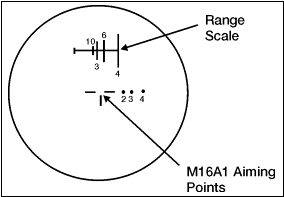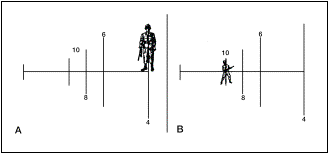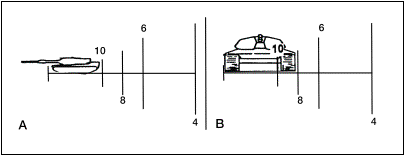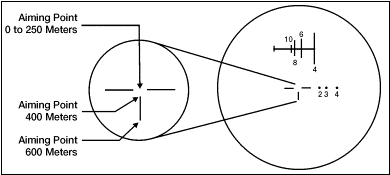|
Performance Steps
|
|
Note. Ensure the AN/PVS-4 has the proper sighting reticle
(figure 071-315-2308-1).
|
|
1. Place the sight into operation.
|
|
2. Use the sight reticle.
When used with the rifle, the
AN/PVS-4 sight reticle consists of two
parts (figure 071-315-2308-1).
|
a.
Use the upper part of the
reticle (range scale) to determine
range to the target.
|
b.
Use the lower part of the
reticle for aiming the weapon.
|
|

Figure 071-315-2308-1.
Sight reticle
|
|
Note. Ensure the AN/PVS-4 is mounted to the rifle using the
rifle mounting adapter and not the
M203 mounting bracket.
|
|
3. Determine range to target.
|
a.
The vertical lines on the
range scale tell the distance from a
6-foot man.
|
(1)
Place the target on the
horizontal line and match it with one
of the vertical lines (A, figure 071-315-2308-2).
|
(2)
Read the number at the
bottom or top of the vertical line.
That is the distance in hundreds of
meters to the target.
|
(3)
If the figure is the same
height as the vertical line above and
below the horizontal line, the
distance will be half the number at
the top or bottom of that line (B,
figure 071-315-2308-2.
|
(4) The man shown in A,
figure 071-315-2308-2
is 400 meters away.
The man in B, figure 071-315-2308-2
is 500 meters away.
|
|

Figure 071-315-2308-2.
Range determination using vertical
lines
|
b.
The horizontal line of the
range scale indicates the range (in
hundreds of meters) of a 20-foot
target such as a tank or large truck
viewed from the side.
|
(1)
Place the left edge of the
vehicle at the left side of the
horizontal line (figure 071-315-2308-3).
|
(2)
Read the range to the tank
from the scale at the right edge of
the tank. As shown in A, figure 071-315-2308-3,
the range to the vehicle is 1,000
meters.
|
(3) When viewed from
the front or rear, the vehicle width
is about half the length. Read the
placement of the vehicle width on the
range scale as half the range scale
value. As shown in B, figure 071-315-2308-3,
the range to the vehicle is 400
meters.
|
|

Figure 071-315-2308-3.
Range determination using horizontal
lines
|
|
4. Engage targets using the sight reticle.
|
a. The rifle aiming point for
ranges out to 250 meters is the center
of the three straight lines (zero
aiming point) (figure 071-315-2308-4).
The top of the vertical line is the
aiming point for 400 meters, and the
bottom of the line is the aiming point
for 600 meters.
|
|

Figure 071-315-2308-4.
Zero aiming point
|
b.
Locate the target, estimate
the range, and place the proper aiming
point on the target.
|
|
WARNING:
To prevent
eye injury from weapon recoil,
attach the eye guard to the sight
before firing the weapon.
|
c.
Fire the weapon using
correct marksmanship procedures.
|
|
Note. When firing
the rifle, disregard the three dots to
the right of the aiming point; these
are needed only when firing the M203.
|